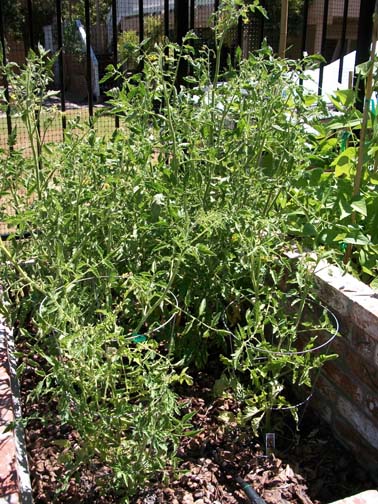Organic, Sustainable, Local
Organic, Sustainable, Local

My 'maters from the garden
Those three terms–Organic, Sustainable, Local–are the foundation for healthy, environmentally sound, and community conscious eating. The farmers markets here in the Sierra Foothills are opening for business, home gardens will soon yield their summer treasures, and the many CSA’s (community farms) that dot the landscape in Nevada and Placer counties are getting the produce boxes ready for delivery to families–or for pick-up for those who like to go out to the farm to see where their food is actually grown.
“Mom, where do vegetables come from?”
“Between the frozen food section and the deli, don’t ask stupid questions.”
Organic. Organic is a slippery term, and oft-abused. Here’s the definition from the USDA which determines organic standards: “Organic food is produced using sustainable agricultural production practices. Not permitted are most conventional pesticides; fertilizers made with synthetic ingredients; or sewage sludge; bioengineering; or ionizing radiation. Organic meat, poultry eggs, and dairy products come from animals that are given no antibiotics or growth hormones.”
Sustainable. “Farming in a way that does not deplete the natural resource, but continues it in a way that will allow it to be productive indefinitely”. The problem with this definition is that it is probably impossible to achieve, even under the most exacting laboratory controlled circumstances. And it has been tried, over and over and over. So far, there has always been some loss of mass, requiring “inputs” of new mass to replace the loss. Expert farmers can get close to this ideal, very close indeed, but eventually even they have to supplement with “inputs.”
Local. How local is local? Barbara Kingsolver (the author) embarked on a “local” eating experiment for a year. She wrote about that arduous undertaking in her wonderful book, Animal, Vegetable, Miracle. In Kingsolver’s experiment, she defined “local” as “within one hundred miles.” Could a modern American family actually provide itself with a healthy diet eating only foods grown within one hundred miles? Yes. But, it’s not easy, and you have to live in a fortuitous location that allows for very long growing seasons and a wide variety of crops.
Think about the area where you live. What is grown there? What is not grown there, the foods you have to import. If you could not bring in imported food, what would you miss most?
If you had to live “locally,” and you could only supplement your diet with one imported food item, what would that one item be?
Oranges?
Chocolate?
For me, the answer is easy: Coffee!
If you enjoyed reading this article, and want to find out more,
just CALL CJ at (530-906-4715) or subscribe below.
Stay Informed
Get the latest posts delivered direct to your email
